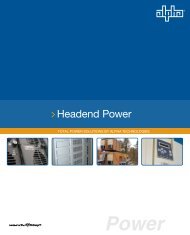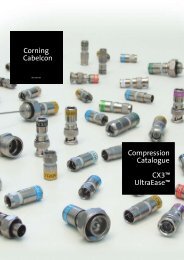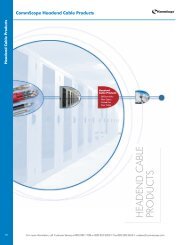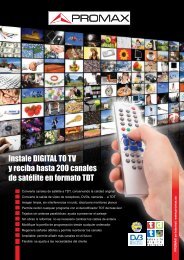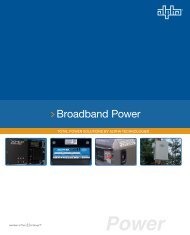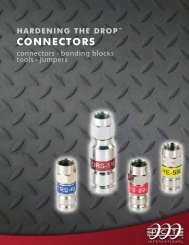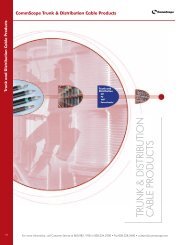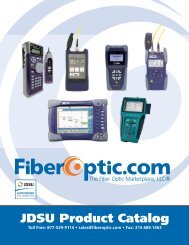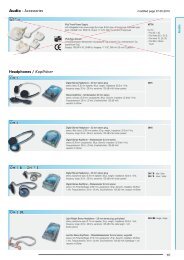C O N Q U EST C O N D U IT PRO D U C TS - KABELKON
C O N Q U EST C O N D U IT PRO D U C TS - KABELKON
C O N Q U EST C O N D U IT PRO D U C TS - KABELKON
You also want an ePaper? Increase the reach of your titles
YUMPU automatically turns print PDFs into web optimized ePapers that Google loves.
ConQuest ®<br />
Toneable Conduit TM<br />
Technical Report - Out of Sight Might Make You Go Out of Your Mind<br />
for underground plant are significantly lower than aerial<br />
plant that is constantly exposed to a harsh environment.<br />
The disadvantages are less obvious. There is a lot<br />
of digging going on around communities, and utility<br />
easements are becoming more and more congested.<br />
And when excavation for the buried utilities begins, the<br />
problems accumulate quickly if effective locating is not<br />
done. Here, we will discuss the consequences of not<br />
properly locating utilities, and we’ll discuss best practices<br />
for building an accurately locatable underground plant.<br />
ConQuest ® Conduit Products<br />
Is Your Locating System Booby Trapped?<br />
As a result of many early excavation fatalities, the federal<br />
government passed legislation 29 CFR 1926.651* as a<br />
measure to protect workers from the hazards of excavating<br />
in areas where buried utilities are located.<br />
Big Money is Lost When Locating Loses Priority<br />
Someone recently asked me, “What is the fastest way to<br />
find a buried telecommunications cable?” Being a little<br />
too spirited, I jested, “With a backhoe.” You’re probably<br />
thinking this cannot be for real. Unfortunately, I could not<br />
be any more real.<br />
Suburban sprawl has prompted community builders<br />
to create an aesthetically pleasing environment and to<br />
remove unsightly utility poles from landscapes. Although<br />
this placement of utilities has been common practice in<br />
new-build constructions for some time, it is starting to<br />
get noticed by older or urban communities that had long<br />
been used to the presence of utility poles. Over the past<br />
few years, in fact, a growing number of communities had<br />
proposed legislation for the removal of utility poles. This,<br />
of course, requires that utility operators relocate their<br />
facilities. Where? You got it – underground.<br />
The advantages of underground installation are proven<br />
time and again. Of course, public safety is improved by<br />
eliminating the hazards of automobile collisions with utility<br />
poles and downed lines during severe weather conditions.<br />
Utility operators and their customers then benefit<br />
from the reduction in outages created by these events.<br />
What’s more, maintenance requirements and expense<br />
Thankfully, today 49 states (not Hawaii) have passed<br />
legislation to mitigate excavation damage. These<br />
state laws require that the location of buried utilities<br />
be marked to both protect workers and prevent utility<br />
service disruption. In most states, the law will not afford<br />
utility operators the right to recover damages if they<br />
failed to properly locate their subsurface plant when<br />
a locate was properly requested. Despite this legislation,<br />
underground utilities continue to be damaged at<br />
alarmingly high rates, and the severity of the damage<br />
has increased as the underground continues to get more<br />
and more congested.<br />
A recent study conducted by the U.S. Department of Agriculture<br />
found that 25% of hits on located facilities were<br />
due to mislocates. In the past five years, there has been<br />
a nation-wide annual average of 21 major underground<br />
fiber optic cables cut, and 39 underground copper trunk<br />
cables cut where locates were off the mark and underground<br />
excavations found them.<br />
The service disruptions from these events affect 911<br />
services, local telephone service, long-distance service,<br />
and nationwide data networks. Service disruption is of<br />
particular concern when it comes to fiber optic cables.<br />
With each optical fiber capable of carrying as many as<br />
30,000 circuits, the revenue loss from service disruption<br />
on a single optical fiber can be as high as $175,000<br />
per minute or more.<br />
For more information, call Customer Service at 800.982.1708 or 828.324.2200 • Fax 828.328.3400 • custserv@commscope.com<br />
C34



